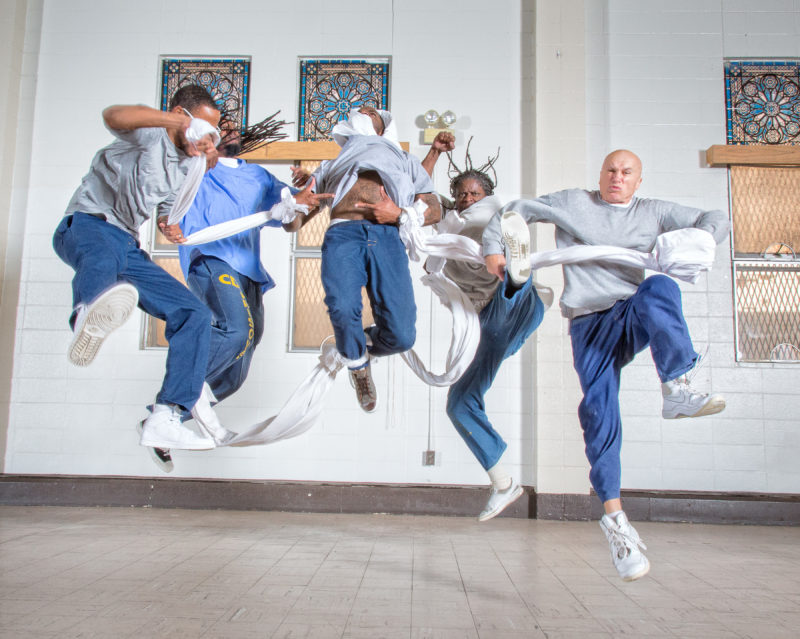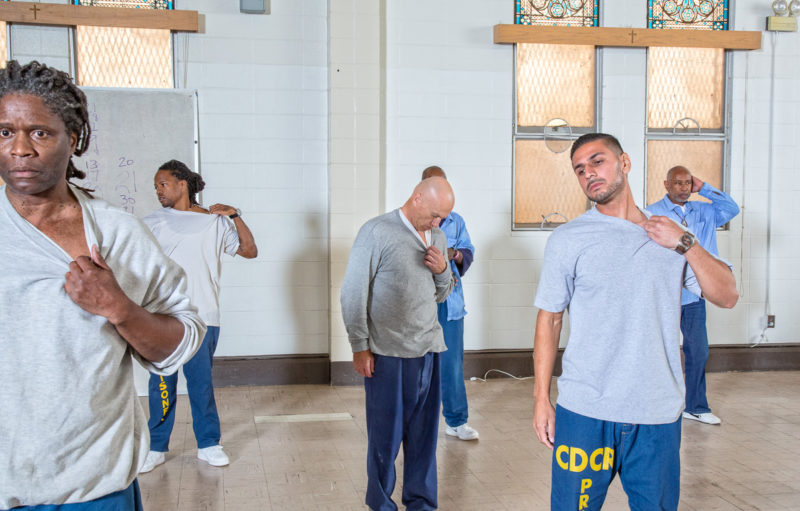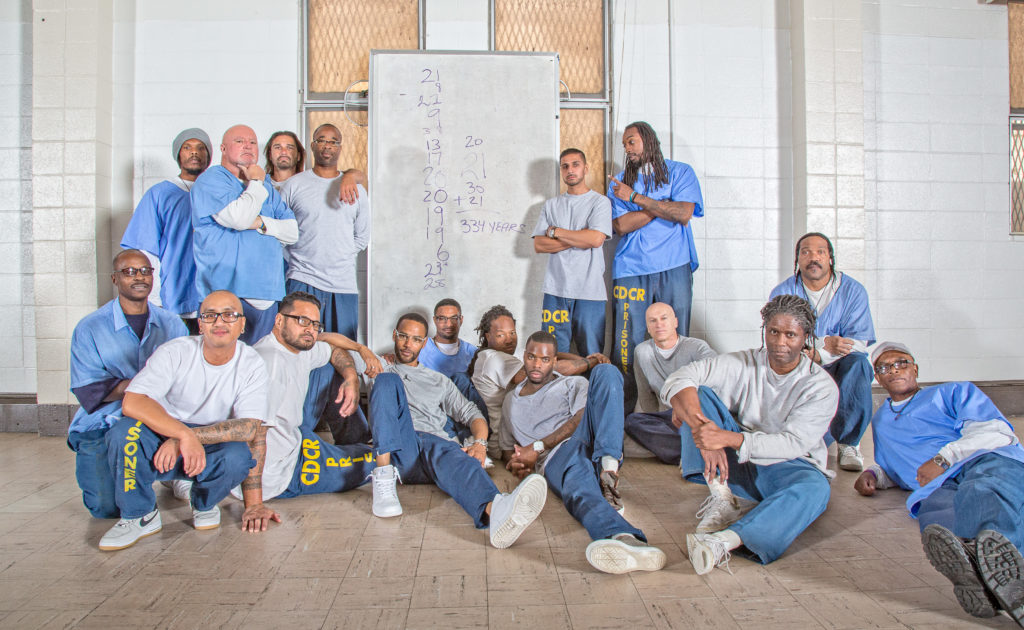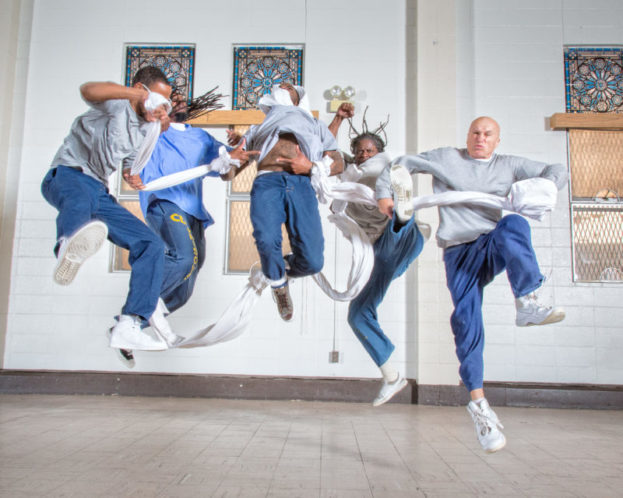
EDITOR’S NOTE: In 2013, the Insight Prison Project, a Restorative Justice organization, approached artists and educators Amie Dowling and Freddy Gutierrez about their desire to bring a dance theater workshop into the Prison. After the 16 incarcerated men who participated in the initial 12-week program expressed a wish to continue, a collective of inside and outside artists, The Artistic Ensemble, was born. Today the group collaboratively generates and creates dance theater, which is presented inside the Prison to audiences comprised of currently incarcerated men and invited guests from outside the Prison.
San Quentin State Prison, opened in 1852 , occupies 275 acres of Marin County, just north of San Francisco. At the time of writing, the four large cell blocks of San Quentin hold 3,760 incarcerated men.
The Artistic Ensemble meets and works together weekly, and has written collaboratively about how the members develop their work within the context of incarceration, including an interview with three who volunteered to share their experiences of participating in the group.
Movement throughout the institution will be regulated by a procedure called controlled movement. The purpose of controlled movement is to ensure that the movement of inmates is orderly. Controlled movements will begin five minutes before the hour and extend for five minutes after the hour. The beginning and end of each move will be announced over the loudspeaker. During this ten-minute period inmates may move from one area of the institution to another.
— Inmate Information Handbook, Federal Bureau of Prisons
The imprisoned body is the primary site of carceral control, an elaborate choreography of containment and segregation. Behind prison walls, regimented rituals of eating, cleaning, labor and leisure curtail individual freedom of movement in the service of “orderly” systems. How, then, do we, an ensemble of inside and outside artists, work within these constraints and confinements?
This article seeks to smuggle inside voices out, and to invite the dance community to engage with incarcerated artists as thinkers and makers.
The Artistic Ensemble at San Quentin Prison is a group of 16 currently incarcerated artists, who, working with five outside members, explore social inequalities through language, sound and movement. As inside members, we turn our constraints and boundaries into new perspectives about how we, and our art, are seen. Our stories cannot be properly told without the echoes of our voices; you cannot picture our world unless we are behind the camera. There is nothing about us, without us.
Questions that shape our work include:
- How do we as artists begin a collective process, where inside and outside artists are working side by side?
- How does transmission occur when stage and audience are separated by a system of mass incarceration that disappears certain bodies?
- How do we use our subversive roles as artists to dismantle the systemic oppression and racism that underlie mass incarceration?
How the Work is Made
After each performance, audience members ask us to explain how we made the work. Often the process is described by what it is not: it is not a play, it does not have characters or a script, it was not made by one individual, it was not easy.

We are striving to create an artistic space within a punitive, regimented, linear system. In this system, a single logic of order prevails—is relied upon—as a means by which rules, hierarchical placement, and right and wrong are deciphered. Our creative process is not linear; inspiration comes from multiple sources—personal story, writing, world events, movement metaphors. Performative structures for those ideas are brought to the group by inside and outside members and developed over months of experimentation.
The three performances we have created are assemblages. Waterline (Nov 2014) was followed by Faultline (Nov 2015), which explored the almost geological weight, time, and pressure of incarceration. In this piece, the collective 334 years served by the Artistic Ensemble members appear both as a crushing total and as a series of daily prison rituals. “What makes us visible?” “Is it possible not to disappear?” These opening questions framed Ways To Disappear (Nov 2016).
As inside and outside artists, working in an inhumane system, we strive to develop a creative process that supports our humanity—one that considers the way we make. The way we attend to ourselves and each other matters: the day-in- and day-out-ness of the work is given as much weight as the day of the performance.
Below are excerpts from an interview with Artistic Ensemble members Anouthinh “Choy” Pangthong (AP), Emile DeWeaver (ED), and Antwan “Banks” Williams (AW).
How would you describe the Artistic Ensemble (AE)?
AP: We are a collective of individuals who created harm in our communities. Today we create works of art that speak to the harm left in our wake. However, there is a greater societal discussion we attempt to provoke through our art, covering socio-economical disparities, gender inequalities, racial differences, racial similarities, immigration, and the like. I’ve been incarcerated for 20 years. Life in prison can become mundane, doing the same thing over and over. Sparks of violence would break the monotony. When an opportunity came to do something different, I jumped at the chance. My life since AE is anything but ordinary.
ED: The Artistic Ensemble is both an artist’s collective and a performance company. We’re seeking supportive space in which to develop creative skills and social connectedness. We’re marginalized people who are blessed to speak universal languages (dance, poetry, song, anguish, desire, joy); in this regard, we’re ambassadors.
How long have you been a performer? What are your influences?
AP: In my teens, I learned how to break dance with cousins. We videotaped ourselves in my uncle’s living room. The movie “Beat Street” had a big influence. And in the backdrop, hip-hop would blast out from sub woofers.
ED: I was a performing musician for seven years before beginning as an actor at San Quentin. Then, through AE, I became interested in dance. My strongest stage influences are incarcerated men: Juan Meza, Antwan “Banks” Williams, and Julian Glenn Padgett. But if I could be anyone on stage, it would be Michael Jackson and Bruce Lee. I’ve loved the way they move since I was a kid. Poetry in flesh.
How do you make work?
ED: Sometimes it’s a zen thing where there’s a sustained intent to create until something comes out. Then I approach the raw material like an editor—mine meaning, and shape it. Other times I’m energized with a feeling or an idea, and then it’s just a matter of scoring a medium—text, movement, music—and exploding. The latter process is rare and a bit of a junky high I chase.
AP: For the most part, our work is collaborative. An idea or concept emerges and what follows is the exploration—developing content, through writing, movement, or group discussions. The exploration piece is probably the most exciting part as an artist, because it allows me to be in creative mode.

In today’s political environment why does art matter?
AW: Art can change the perspective of those in power.
ED: We live in a polarized nation. The hard lines that divide liberal from conservative, believer from non-believer, white male supremacist from incarcerated black female, are deep. But art is a bridge that allows us to experience another’s life, which is the foundation of empathy. Art is a medium capable of confronting its consumers with the human condition, and when we’re confronted by a human face that penetrates all the barriers we create to deny our fraternity with the “other,” the hard lines dissolve. Given all this, art can create a space for dialogues that aren’t happening, dialogues that run across the hard lines.
What do you think about the fact that artists in prisons cannot be compensated, despite how much money is raised for a project?
ED: I think artists should be paid for their work. If they cannot receive money directly, then the money should go into trusts for them to accomplish various things: (1) to support a college education for the artist’s children, (2) as a nest-egg for when the artist paroles, (3) to keep artist in touch with family by paying for phone calls or visiting expenses, (4) to invest (which helps both the economy and the artist), (5) to help support the artist during incarceration (quarterly packages, restitution debts).
Do you consider the work that the Ensemble does as political and/or activist? If so, in what ways?
AW: The work is political/activist. Just because we are in prison does not take away our need/wish to change a society we will ultimately return to. We create pieces that highlight police brutality, immigration and racial inequality. We understand the causes, factors and consequences that lead to and result from the divide and hatred among us.
AP: There are political aspects to our work; however, I believe our core is advocacy for those who suffer injustice created by human hands and institutional establishments. And what I love about AE is that we advocate for hope, compassion, and humanity.
ED: I consider our work political. The politics of fear, retribution, and supremacy that support xenophobia, sexism, and racism are unsustainable in the space our art creates. The Ensemble is devoted to expanding this space, and that is a political act.
How can artists and arts organizations on the outside support your work?
ED: Artists on the outside can support my work by contacting me and inviting me to participate in their communities, by being willing to carry me, like my brothers in the Ensemble do. Artists can support my organization, Prison Renaissance (prisonrenaissance.org). We have a mentorship and collaborations program that unites incarcerated and free artists to create more space where the politics of fear can’t exist. We take donations through our fiscal sponsor, Impact Justice (impactjustice.org). Arts organizations could partner up with re-entry programs to basically hold my hand back into society. They could employ me for 6 months while I get on my feet. They could build art or education programs in the free world where they train and pay family members. They could provide credentials like an MFA.
AP: The biggest support artists on the outside can give us is to acknowledge that there are talented artists on the inside. Prisons confine and separate, but the art that is created on the inside can reach a wider audience with the support of artists on the outside.


